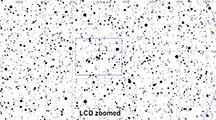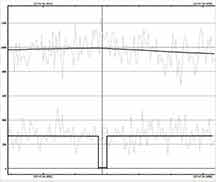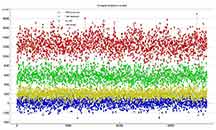


This is a rank=96 event passing through SW Santa Cruz and Kirk and I at home are both inside the path. No real chance for Karl. The event is tough; only 15 degrees altitude in Sagittarius, only 8 degrees from the 92% moon at similar altitude as the star. Will take short integration. I'd suggest 4x and no more. 11.4 should show OK, and if it is 0.5s long, we should be able to detect it. If skies area clean and clear as they seem to be holding as I write this 2 hrs before the event. I can't see if from home at that altitude, so may drive west to try and get it at Wilder Ranch, on the centerline.
The star field is very dense, inside the 'spout' of Sagittarius the Teapot, in the outer bulge of the Milky Way. I could not plot the eyepiece field with all the stars, getting an error in C2A. Instead I just have the brighter SAO stars, and a star cluster labelled. I also have a zoomed version of the LCD chip, to identify the target in a small triangle of similar stars.
 |
 |
 |
Kirk and I both got recordings from our homes. Skies were clear, seeing good (for 15 deg altitude anyway), no wind. The nearby moon definitely made for washout skies at 8x, acceptable but bright at 4x, and the target was ~too hard to see at 2x. We both set our gear to 4x integrations.
Contrary to my first assumption, the target actually WAS visible from home, so I cancelled plans to drive to Wilder Ranch. The tree trimmers a month ago helped by trimming the neighbor's hedge. I could probably get alt=13 or maybe even 12 degreees in that direction, if the hedge were to not grow. The sky had no clouds over the target, and felt dry.
The target was much harder to see on the reductions in PyMovie than I thought it would be, especially during the minute centered on the event. It got easier to see during the final minute, perhaps because it was a bit higher in the sky. However, due to the nearby faint stars, I decided to use a TME aperture. Also, the bright sky seemed to make for a complete histogram for the sky, no clipping as can happen for dark skies. I used 4x. The plots actually make a good case for a miss. I was worried I'd not be able to conclude much as I figured the target would be lost in the sky. But it actually came through OK.
 |
 |
 |
 |
 |
I don't see an event for 2000 SD 176, 4x from home. The moon was close and the target was only 15 degrees up, southeast over the city skyglow. The target was barely visible at 4x, but 8x was too washed out. It's visible in pymovie using the finder, I tried TME aperture but there's no apparent event. I did smoothing in pyote, and used the detectability tool, it said it would be detectable at a minimum of .35 seconds, even at a mag drop of 1.8, predicted max for this was .48 sec. The OW cloud page and charts showed the target had stars close nearby, it gave three different mag drops, 8m, 1.9m, and 1.8 mag. I also tried a 12-stack of static apertures in pymovie, still don't see an event. So I guess I can report a miss, but I was close to the centerline.
 |
 |
 |
 |